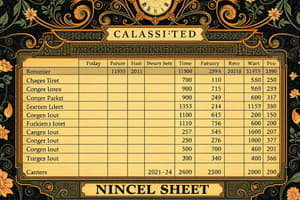Podcast
Questions and Answers
What are the 4 standard classifications of assets?
What are the 4 standard classifications of assets?
- Property, Plant and Equipment (correct)
- Long-term Investments (correct)
- Intangible Assets (correct)
- Current Assets (correct)
What is the balance sheet classification for assets that are expected to be converted to cash or used up within 1 year?
What is the balance sheet classification for assets that are expected to be converted to cash or used up within 1 year?
Current Assets
Which of the following are considered current assets? (Select all that apply)
Which of the following are considered current assets? (Select all that apply)
- Debt investments (savings account) (correct)
- Accounts Receivable (correct)
- Cash (correct)
- Land
What type of assets are investments in stocks and bonds of other companies held for more than 1 year?
What type of assets are investments in stocks and bonds of other companies held for more than 1 year?
What is the balance sheet classification for stock investments, real estate, and long-term bonds?
What is the balance sheet classification for stock investments, real estate, and long-term bonds?
What are assets with long useful lives that are currently used called?
What are assets with long useful lives that are currently used called?
Which of the following are classified as Property, Plant, and Equipment? (Select all that apply)
Which of the following are classified as Property, Plant, and Equipment? (Select all that apply)
What type of assets do not have a physical substance but are often valuable?
What type of assets do not have a physical substance but are often valuable?
What is the balance sheet classification for patents, goodwill, and trademarks?
What is the balance sheet classification for patents, goodwill, and trademarks?
What are the standard classifications for liabilities and stockholders' equity?
What are the standard classifications for liabilities and stockholders' equity?
What are obligations that a company is expected to pay within the coming year?
What are obligations that a company is expected to pay within the coming year?
What is the balance sheet classification for notes payable, accounts payable, and unearned revenue?
What is the balance sheet classification for notes payable, accounts payable, and unearned revenue?
What type of liabilities are expected to be paid after 1 year?
What type of liabilities are expected to be paid after 1 year?
What is the balance sheet classification for common stock and retained earnings?
What is the balance sheet classification for common stock and retained earnings?
What is common stock?
What is common stock?
What are retained earnings?
What are retained earnings?
What does a classified balance sheet report?
What does a classified balance sheet report?
What does a classified balance sheet determine?
What does a classified balance sheet determine?
What is an operating cycle?
What is an operating cycle?
What is liquidity?
What is liquidity?
What is depreciation?
What is depreciation?
What is accumulated depreciation?
What is accumulated depreciation?
Flashcards are hidden until you start studying
Study Notes
Standard Classifications of Assets
- Assets are categorized into Current Assets, Long-term Investments, Property, Plant, and Equipment (PPE), and Intangible Assets.
- Current Assets are anticipated to be converted into cash or consumed within one year, and they are arranged by liquidity.
Current Assets
- Examples include Cash, Accounts Receivable, Inventory, Supplies, and Prepaid Insurance/Rent.
- Listed in order of liquidity, meaning the ease of conversion to cash.
Long-term Investments
- Comprises investments in stocks and bonds of other companies held for more than one year, and assets like land or buildings not currently being utilized.
Property, Plant, and Equipment (PPE)
- Includes assets with long useful lives actively in use, also referred to as Fixed Assets or Plant Assets.
- Ordered by size of value, from largest to smallest.
Intangible Assets
- Assets that lack physical substance but hold significant value, such as Patents, Goodwill, Trademarks, and Copyrights.
Standard Classifications for Liabilities and Stockholders' Equity
- Divided into Current Liabilities, Long-term Liabilities, and Stockholders' Equity.
Current Liabilities
- Obligations the company must settle within the coming year, including Notes Payable, Accounts Payable, and Unearned Sales Revenue.
Long-term Liabilities
- Obligations expected to be paid after one year, such as Mortgages Payable, Long-term Notes Payable, and Bonds Payable.
Stockholders' Equity
- Comprises Common Stock, representing ownership investments by shareholders, and Retained Earnings, funds retained within the business and not distributed as dividends.
Classified Balance Sheet
- Reports assets, liabilities, and equity at a specific point in time.
- Assesses the company’s ability to meet obligations, and evaluates creditor claims on total assets.
Operating Cycle
- Refers to the duration from inventory acquisition to cash collection from customers, typically around one year.
Liquidity
- The measure of how easily an asset can be converted into cash, determining the order of Current Assets on the balance sheet.
Depreciation
- The systematic allocation of the cost of PPE assets over their useful lives. PPE is listed from the largest to the smallest based on value.
Accumulated Depreciation
- Represents the total depreciation charged on assets over time, calculated as the asset cost less accumulated depreciation.
Key Definitions
- Current Liabilities: Obligations due within the next year or operating cycle.
- Long-term Liabilities: Obligations due after one year.
Studying That Suits You
Use AI to generate personalized quizzes and flashcards to suit your learning preferences.




